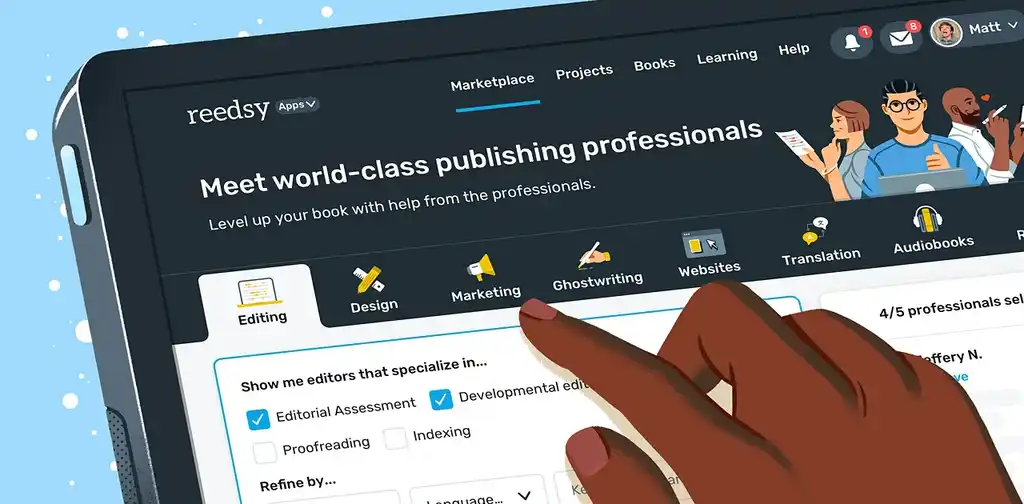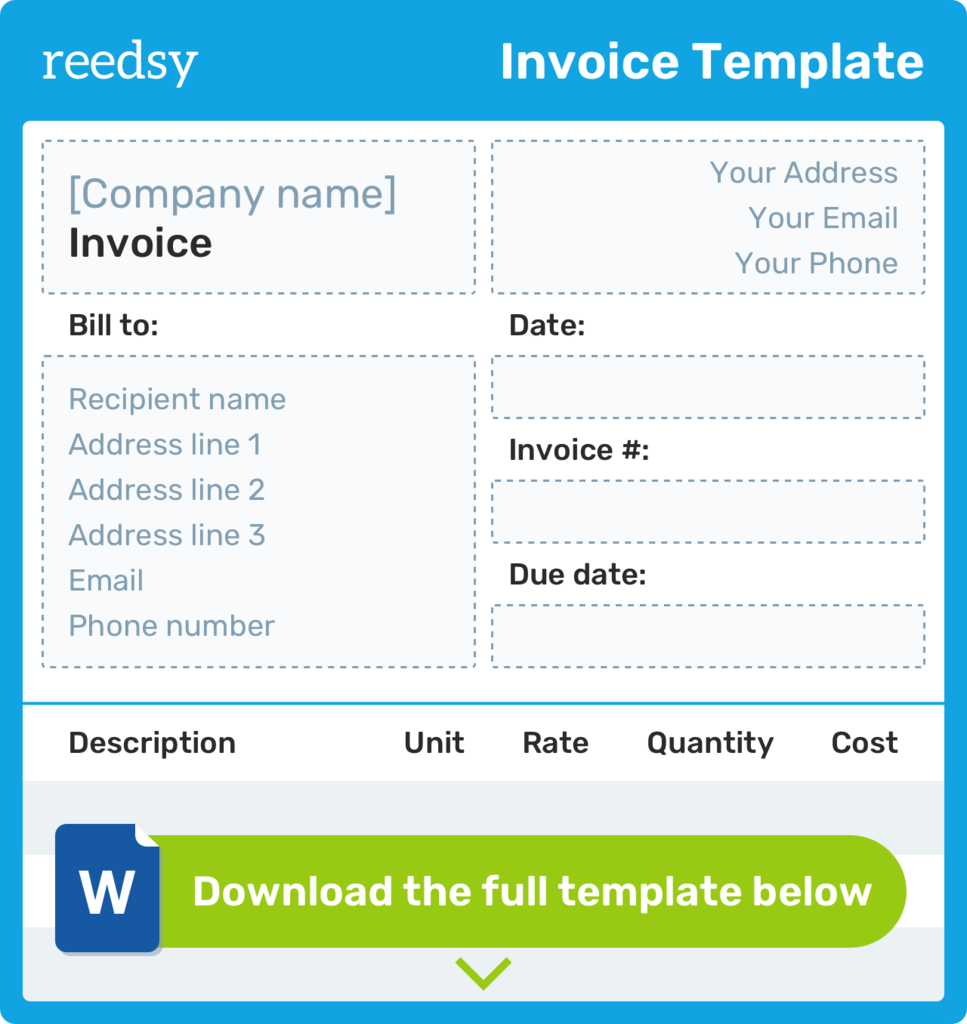Blog •
Posted on Dec 09, 2020
How to Write a Freelance Invoice (+ Template)
About the author
Reedsy's editorial team is a diverse group of industry experts devoted to helping authors write and publish beautiful books.
More about the Reedsy Editorial Team →Your work is complete, your client’s happy, now you can just sit back and relax — right? Not so fast. The perks of being a freelancer are endless, but freelancing also means taking care of all the nitty-gritty details yourself, like filling out a freelance invoice to make sure you get paid. And that’s not to mention how much easier your life will be come tax season if you’ve already documented and itemized your income in the form of invoices.
And while freelance invoices may not be the most thrilling, they certainly don’t need to be tricky — we’re here to help!

FIND CLIENTS
Grow your business on Reedsy
Submit your application to join our curated network and connect with clients.
Download: Freelance Invoice Template
Almost all invoices are identical: it’s a document that details the goods or services that you have provided for a client and the payment that is due for them. To save you the hassle of coming up with your own, we’ve created this professional template that you can simply download and fill in. Saving time on mundane things like this will allow you to devote more time and effort to the things that really matter: attracting new clients and, well, doing your job.


FREE RESOURCE
Invoice Template
Provide billing and payment details with this professional template.
Creating your own freelance invoice: what to include
If you’re looking for a more detailed explanation of what you’ll find in that template — or wish to create your own invoice from scratch — we’ve got you covered. Here’s what to put on a freelance invoice to make sure it gets the job done.
Q: How do you handle clients who delay payment?
Suggested answer
When working through Reedsy, I really haven't had much of a problem in this regard. The team here manages the payment system extremely well. Occasionally, an author has a problem with payment, especially if they are in a different country to me, because banks and credit cards can be very wary of international transactions. But because Reedsy ensures that clients have entered their payment details up front, I've not found it to be a problem here, and that's one of the advantages of taking work through the site.
I do, of course, get some clients direct and through other means. I think it's very important to make sure they understand your payment requirements, so I tend to discuss the specifics upfront but only invoice them at the end of a job. My invoice will include payment terms, a maximum of 30 days.
I'm in the UK, and there are guidelines and laws for late payment in this country. If a client is more than a month late in paying, you are able to charge them a late payment fee and also interest on the outstanding amount. A simple Google search will show you what those guidelines are. If you're in other countries, the rules may be slightly different. I'll be honest, I've never had to do this with an author client, but I've had to do it many times with publisher clients.
Scott is available to hire on Reedsy ⏺
When working with authors to create their websites, I understand that they often juggle multiple responsibilities, from cover and interior book design to a day job, sometimes leading to shifting deadlines. To ensure a smooth process, I prioritize clear and timely communication.
I provide regular updates and reminders during the project to help clients stay on track with milestones. If delays arise, I encourage authors to communicate these as soon as possible. This allows us to adjust the timeline without compromising the quality of the final product. In my experience, this collaborative approach helps us navigate unforeseen challenges effectively.
My contract includes a clause allowing for a maximum two-week extension if the delay is communicated in advance. This provides flexibility while maintaining a reasonable timeframe for completing the project. Longer extensions are considered in exceptional cases, such as health issues, and I work closely with the client to develop an adjusted timeline that works for both parties.
By maintaining open communication and setting clear expectations, I aim to accommodate clients’ needs while ensuring the project progresses efficiently. This approach balances understanding the authors’ unique challenges with the structure needed to deliver a professional website on time.
Elena is available to hire on Reedsy ⏺
I understand that clients may have valid reasons for payment delays, so I try to approach these situations with patience and professionalism. However, I ensure to follow up regularly, usually every one to two weeks, depending on how detailed is their reason. To avoid prolonged delays, I make sure my payment terms are clearly outlined in the offer, including deadlines and any applicable late fees. This helps set expectations upfront while maintaining a respectful relationship.
Vittoria is available to hire on Reedsy ⏺
💡 These days, many freelancers prefer to send invoices electronically via email or another platform. Whether you choose to send paper or digital invoices, make sure that your client knows how they will receive theirs.
Company name and logo
More likely than not, yours will not be the only invoice that your client receives in the course of business — and even if it is, you want to be absolutely clear from whom this invoice is coming.
Put the name of your company or the professional name under which you operate at the top of the page, large and clear. Near your company name, you should also write the word invoice so that your client knows exactly what they’re looking at when they open the document.
If you have a logo, include this as well. Not only will it make your invoice look more professional, it also provides an easy way to let your client know who it’s coming from.

Contact information
Both you and your client’s contact information should appear on the invoice. This includes:
📬 The full addresses if you have them
📧 Email addresses
☎️ Phone numbers
📁 Your contact’s name or the purchase order number (the PO number). If the company is big enough, the client will send you a PO number so that THEIR accounts department can keep track of things.
Besides being a standard professional measure, having both parties’ contact information in your invoice creates a useful reference point for both of you. If either of you needs to contact the other regarding payment or any other important matter, you’ll have everything you need to do so.
Invoice number
Unless you want yourself and your clients to end up wading through stacks of indistinguishable invoices, it’s imperative to include an invoice number at the top of each separate invoice. Since this is for organizational purposes, it is up to you to choose your preferred numbering system, but make it logical and keep it consistent so that no one gets confused. Your numbering system should be such that no two invoices, even for different clients, have the same number. Keeping track of invoices is the ticket to making sure they all end up getting paid, and you certainly don’t want that to get muddled with repeating numbers.
Dates
There are two important dates that you need to include in your invoice:
- Date prepared: This is the date on which the invoice was created. This allows you to keep track of when you have sent invoices out and how long the invoice has been with your client.
- Date due: A reasonable due date to set is around 14 days after the invoice was sent. Be prepared to follow up if you haven’t heard from the client by that date.
Breakdown of services
In a freelance invoice, always include an itemized breakdown of the services for which you expect payment.
This breakdown should include:
- A description of each individual service
- The unit of measurement for your work (e.g. per hour or per word)
- Your rate for that service
- The quantity of units that your client is paying for
- The total cost
Here it’s best to be as specific as possible, laying the services out clearly, with each on its own line so that the invoice is easy for your client to understand. If you're a ghostwriter as well as an editor for a project, and you issue one invoice, you'd want to have space in your freelance writer invoice template, accounting for both the writing and the revisions. Going step-by-step like this will also make sure you are not under- or over-charging.
For example, if you are a freelance proofreader who charges by the word, your breakdown of services might look something like this:

❗️ An invoice shouldn’t be the first time your client hears exactly what the services and prices will be! This information should be provided early in the collaboration as a quote or proposal and agreed upon before work begins.
Subtotal
Your subtotal is the sum of all the amounts listed in your breakdown of services. You want your calculations to be completely transparent and your client able to track how you arrived at this subtotal — so double-check to make sure that it directly corresponds to the listed amounts.
Adjustments to subtotal; tax or discounts
That said, even once you have calculated the subtotal based on your fixed rates, it may not be the total amount due from your client. There may be adjustments that need to be made for tax reasons, or if you are offering some kind of discount. Again, set these out clearly so that your client can follow how these have affected the previously stated subtotal.

Grand total
This is the total amount that you expect your client to pay. Indicate this clearly on the page, perhaps in a larger or bold font than the rest of the invoice, after adjustments to the subtotal.
💡 Some freelancers choose to put the total payable amount at the top of the invoice in a standalone box or another eye-catching format. This serves as an “invoice at a glance” while allowing clients to read further into the specifics if they like.
Payment terms
Finally, you’ll want to include brief payment terms, which is all the relevant information surrounding payment. Here are some key things it will be useful to include:
- Payment options: Bank transfer, Paypal, cheque — you can list one or several of the following methods, whichever works best for you. This ensures your payments stay where you want them to, and also helps you to avoid any payment scams.
- Payment details: Whatever you listed in the “options” section, you should provide your account details for that here.
- Late or early payments: In order to deter late payments and/or encourage early payments, you can set up penalties or reward discounts. The terms and relevant time frames for these should be clearly set out in your payment terms so that your client is aware in advance.
💡 If you intend to offer a discount for early payment, you can factor this into your initial quote.
Personal note
While this is not strictly necessary and your invoice will function perfectly well without one, it’s always nice to add a personal touch. This is the sort of “extra mile” measure that will help you stand out and keep clients coming back — one of many small things you can do to grow your business. It doesn’t have to be War and Peace: just add a short simple message acknowledging that you’ve enjoyed working with them (and that you’re available for more work any time).
The secret to successful invoicing lies in staying on top of things. So long as you can keep track of which invoice you sent when and whether it has been paid, the days of payments slipping through the cracks are behind you.
Q: How does Reedsy help with the invoicing process?
Suggested answer
Reedsy handles invoicing and payment so editors don't need to worry about it at all
John is available to hire on Reedsy ⏺
Reedsy and Stripe take a percentage fee from my quote and for that they handle everything: the author's bank details, follow-up and all parts of the bank transaction. I get an invoice and a monthly tax statement to send to my accountants. It's a great service which avoids me having to do a lot of toing and froing with an author about payment dates, choice of currency, bank details and charges. I factor those fees into my quote, of course.
Alex is available to hire on Reedsy ⏺
Reviewed by Linnea Gradin
The editor-in-chief of the Reedsy Freelancer blog, Linnea is a writer and marketer with a degree from the University of Cambridge. Her focus is to provide aspiring editors and book designers with the resources to further their careers.
As the editor of Reedsy’s freelancer blog and a writer on the Reedsy team, Linnea has her hand in a bit of everything, from writing about writing, publishing, and self-publishing, to curating expert content for freelancing professionals. Working together with some of the top talent in the industry, she organizes insightful webinars, and develops resources to make publishing more accessible to writers and (aspiring) publishing professionals alike. When she’s not reading, she can be found dribbling on the football pitch, dabbling in foreign languages, or exploring the local cuisine of whatever country she happens to be in at the time.

